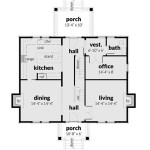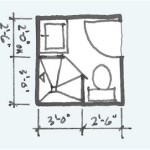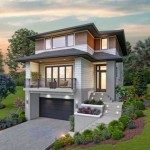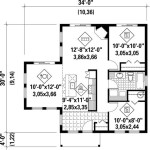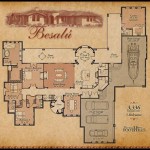Tiny House Plans: Maximizing Functionality in 600 Square Feet
The tiny house movement has gained significant momentum in recent years, driven by a desire for simpler living, financial freedom, and reduced environmental impact. While the definition of "tiny" can vary, a common benchmark is a dwelling under 600 square feet. Opting for tiny house plans within this size constraint requires careful planning and prioritization of functionality to ensure comfortable and efficient living.
Designing a tiny house, particularly one capped at 600 square feet, demands meticulous attention to detail. Every inch of space must be optimized to serve multiple purposes. This article explores key considerations in developing successful tiny house plans for a 600-square-foot dwelling, focusing on layout strategies, storage solutions, material selection, and essential features.
Strategic Layout Design for Efficient Living
The layout is the foundation of any successful tiny house design. Within 600 square feet, a well-considered layout can significantly impact the perceived spaciousness and overall functionality of the dwelling. Open-concept designs are highly prevalent in tiny houses, combining the living area, kitchen, and sometimes even the bedroom into a single, flowing space. This approach eliminates unnecessary walls, maximizing the usable area and creating a sense of openness.
Zoning within an open-concept layout is crucial. This can be achieved through subtle architectural cues such as changes in flooring, varying ceiling heights, or the strategic placement of furniture. For example, a raised platform could delineate the bedroom area, providing a sense of separation without the need for a full wall. Similarly, a kitchen island can serve as a visual barrier between the kitchen and living areas while also providing valuable countertop space and storage.
Vertical space utilization is paramount. In a small footprint, building upwards can significantly expand the living area. Lofts are a common feature in tiny houses, often used for sleeping areas to free up floor space below. A well-designed loft should consider headroom requirements and accessibility via a sturdy ladder or staircase. Staircases, in particular, can be cleverly integrated with storage solutions, such as built-in drawers or shelves, to maximize their utility.
Circulation paths should be carefully planned to ensure smooth movement throughout the tiny house. Avoid creating bottlenecks or dead-end spaces that can make the dwelling feel cramped. Consider the natural flow of activities and design the layout to accommodate these movements efficiently.
Natural light plays a vital role in making a small space feel larger and more inviting. Maximize the use of windows and skylights to bring in ample sunlight. Strategically placing windows to capture views can also enhance the connection to the outdoors and create a sense of spaciousness. Consider the orientation of the house to optimize solar gain for heating in the winter and minimize overheating in the summer.
Innovative Storage Solutions and Space-Saving Furniture
Storage is often a significant challenge in tiny houses. Employing innovative storage solutions is essential to keep the space organized and uncluttered. Multifunctional furniture is a key component of effective storage design. Consider furniture that serves dual purposes, such as a sofa bed, a storage ottoman, or a dining table that can fold down when not in use.
Built-in storage is another valuable strategy. Custom-built cabinetry can be tailored to fit the specific dimensions of the tiny house, maximizing the use of every nook and cranny. Consider incorporating storage into unexpected places, such as under the bed, in the risers of the staircase, or along the walls. Vertical shelving can also provide ample storage space without taking up valuable floor area.
Consider using wall-mounted storage solutions, such as shelves and hooks, to keep items off the floor and free up space. These solutions are particularly useful for storing smaller items, such as books, tools, and kitchen utensils. Utilize the vertical space effectively by installing shelves that extend to the ceiling.
The kitchen is often a focal point for storage challenges in a tiny house. Maximize cabinet space by using pull-out shelves and organizers. Install a magnetic knife strip on the wall to free up counter space. Consider using a compact refrigerator and other appliances to save space. Explore vertical storage solutions, such as a hanging spice rack or a pot rack, to keep the countertops clear.
For clothing storage, consider using a modular closet system or a wardrobe with built-in drawers and shelves. Utilize vacuum-sealed bags to compress clothing and bedding when not in use. Explore under-bed storage options, such as drawers or rolling bins, to maximize the use of available space.
Material Selection and Essential Features for Comfortable Living
The materials used in a tiny house can significantly impact its aesthetics, durability, and overall functionality. Opting for lightweight and durable materials is crucial, particularly for structures built on trailers. Consider using sustainable and eco-friendly materials whenever possible to minimize the environmental impact of the tiny house.
Lightweight framing materials, such as steel or engineered wood, can reduce the overall weight of the structure and make it easier to transport. For siding, consider using materials like cedar shingles or metal cladding, which are both durable and aesthetically pleasing. For roofing, metal roofing is a popular choice due to its durability, longevity, and reflectivity.
Interior finishes should be selected for their durability, ease of maintenance, and aesthetic appeal. Consider using light-colored paint and flooring to create a sense of spaciousness. Hardwood flooring is a durable and attractive option, while laminate flooring is a more affordable alternative. For walls, consider using shiplap or tongue-and-groove paneling to add texture and visual interest.
Essential features for comfortable living in a tiny house include a functional kitchen, a comfortable sleeping area, a well-designed bathroom, and adequate heating and cooling systems. The kitchen should be equipped with a sink, a cooktop, a refrigerator, and sufficient counter space for food preparation. The bathroom should include a toilet, a shower, and a sink. Consider using a composting toilet or a waterless urinal to conserve water.
Heating and cooling systems are essential for maintaining a comfortable indoor temperature throughout the year. Consider using a mini-split heat pump, which is energy-efficient and can provide both heating and cooling. A wood-burning stove can also be a viable option for heating, but it requires careful installation and ventilation. Insulating the tiny house properly is crucial for minimizing energy consumption and maintaining a comfortable indoor temperature.
Ventilation is also critical to prevent moisture buildup and ensure good indoor air quality. Install exhaust fans in the kitchen and bathroom to remove moisture and odors. Consider using a whole-house ventilation system to circulate fresh air throughout the tiny house.
Water and electrical systems must be carefully planned and installed by qualified professionals. Ensure that the tiny house is properly wired for electricity and plumbed for water and waste disposal. Consider using a rainwater harvesting system to collect and store rainwater for non-potable uses, such as watering plants and flushing toilets.
Finally, consider the aesthetic aspects of the tiny house. Choose a design style that reflects personal preferences and complements the surrounding environment. Pay attention to details, such as the color scheme, the lighting fixtures, and the hardware used throughout the tiny house. A well-designed and aesthetically pleasing tiny house can be a comfortable and enjoyable place to live.

Tiny Home Plan Under 600 Square Feet 560019tcd Architectural Designs House Plans

600 Square Foot Tiny House Plan 69688am Architectural Designs Plans

600 Sq Ft House Plan Small Floor 1 Bed Bath 141 1140

Panther Plan 600 Sq Ft

600 Sq Ft Tiny House Design Cost Living United Homes

Pin Page

Panther Plan 600 Sq Ft Cowboy Log Homes

600 Sq Ft House Plans Designed By Residential Architects

Floor Plans Veterans 1st Of New

Modern Style House Plan 1 Beds Baths 600 Sq Ft 48 473

